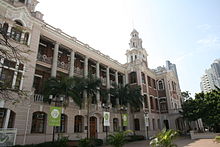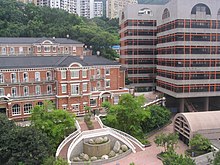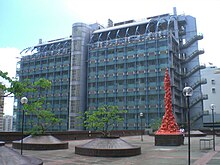
St. Paul's College is an Anglican day school for boys in Hong Kong. It was established in 1851, the oldest continuously operated school in Hong Kong. The college first opened in 1851 with only one tutor and nine pupils. Today, it has more than 1,200 pupils in the secondary section and nearly 600 pupils in the primary section.
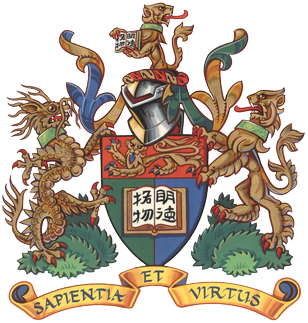
The University of Hong Kong (HKU) is a public research university in Pokfulam, Hong Kong. It was founded in 1887 as the Hong Kong College of Medicine for Chinese by the London Missionary Society and formally established as the University of Hong Kong in 1911. It is the oldest tertiary institution in Hong Kong.

Mid-Levels is an affluent residential area on Hong Kong Island in Hong Kong. It is located between Victoria Peak and Central. Residents are predominantly more affluent Hong Kong locals and expatriate professionals.
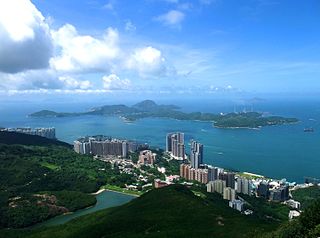
Pok Fu Lam (薄扶林) or Pokfulam is a residential area on Hong Kong Island, at the western end of the Southern District. It is a valley between Victoria Peak and Mount Kellett, around Telegraph Bay.

Shek Tong Tsui or Belcher Point is an area in Sai Wan on Hong Kong Island in Hong Kong. Administratively, it belongs to the Central and Western District.

HKU is a station on the Hong Kong MTR Island line located in the Shek Tong Tsui neighbourhood of Western, Hong Kong. The station is named after the adjacent University of Hong Kong.

Sai Ying Pun is an area in Sai Wan, on Hong Kong Island, in Hong Kong. It is administratively part of the Central and Western District.
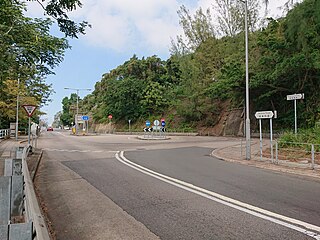
Victoria Road is a main road near the west shore of Hong Kong Island in Hong Kong connecting Kennedy Town and Wah Fu and an alternative connection of Pok Fu Lam Road. It begins north with Belcher's Street in Kennedy Town and goes along Mount Davis, Sandy Bay, Telegraph Bay and Waterfall Bay and reaches in Kellett Bay.

Sir Hormusjee Naorojee Mody was an Indian Parsi businessman in Hong Kong. He lived in Hong Kong for 50 years, during which he worked for the colony and founded the University of Hong Kong.

St. John’s College is an Anglican college affiliated to the University of Hong Kong, which provides accommodation to undergraduates and postgraduates. As the successor of St. John’s Hall, which was founded in 1912, the College is the oldest residential hall/college of the University. Constitutionally, the College is a body corporate established by statute, the St. John’s College Ordinance, on 27 April 1956. As such, unlike other residential halls/colleges that are directly administered by the University, the College enjoys financial and administrative independence. The Ricci Hall, run by the Jesuits, is the only other non-University-administered hall.
This page describes residential halls, colleges and residences at the University of Hong Kong (HKU).

High Street is a one-way street in Sai Ying Pun, Hong Kong, available only to minibuses and private vehicles. It connects Bonham Road in the east and Pok Fu Lam Road in the west. It runs from east to west from Western Street to Pok Fu Lam Road, and from west to east from Western Street to Bonham Road. It was originally named Fourth Street, but because the number four is commonly avoided in Chinese culture, the government changed the name to High Street.

Cape D'Aguilar Marine Reserve is the only Marine Reserve in Hong Kong. It is located at the far south-east corner of Hong Kong Island and covers an area of just 20 hectares, mainly between Kau Pei Chau and the rocky coastline. It was designated in July 1996 under the Marine Parks Ordinance to protect the rocky shores and the subtidal habitats in the area.
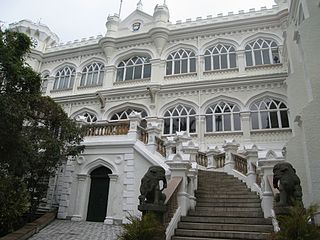
University Hall, or UHall, is a historical residential hall for males at the University of Hong Kong. University Hall is one of the oldest residential halls under the university's hall system and houses about 110 students. Its hall colours are green, black and silver. It is located at 144 Pok Fu Lam Road, close to the Pok Fu Lam Reservoir within the Pok Fu Lam Country Park on the western side of Hong Kong Island.

University, formerly called Mid Levels West before 1994, is one of the 15 constituencies in the Central & Western District of Hong Kong.

Hong Kong Chinese Christian Churches Union Pok Fu Lam Road Cemetery or Hong Kong Chinese Christian Churches Union Pokfulam Road Cemetery is a cemetery in Pok Fu Lam, Hong Kong. It is managed by The Hong Kong Chinese Christian Churches Union (香港華人基督教聯會). It lies on the slopes east of Victoria Road between Tung Wah Coffin Home and Pok Fu Lam Road, facing Sandy Bay.

Fung Ping Shan Building is a building of the University of Hong Kong and a declared monument. It is located at 94 Bonham Road, Sai Ying Pun, Hong Kong Island, Hong Kong on the campus of the University of Hong Kong. It is currently being used as the University Museum and Art Gallery.

The Main Building of the University of Hong Kong is the oldest building of the University of Hong Kong. It is located on the main campus on Bonham Road and Pok Fu Lam Road in Pok Fu Lam, Hong Kong Island, Hong Kong. It was built in the architectural style of Edwardian Baroque and designed by Alfred Bryer of Leigh & Orange and is of three storeys high. The exterior of the building has been a declared monument in Hong Kong since 1985.
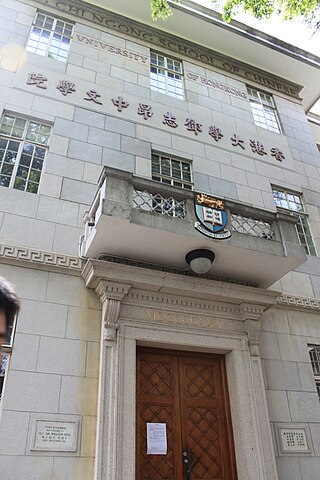
The Tang Chi Ngong Building is a building of the University of Hong Kong. It is located on the main campus near Pok Fu Lam Road in Pok Fu Lam, Hong Kong Island, Hong Kong. It opened in 1931 and currently houses the Jao Tsung-I Petite Ecole. The exterior of the building became a declared monument in 1995.

The Eliot Hall and May Hall are both buildings located in the University of Hong Kong. The two halls are declared monuments of Hong Kong and were built in the Edwardian architectural style modelled after the even older pre-existing Lugard Hall. They were both designed by local Hong Kong Architects, Denison, Ram and Gibbs, which the two halls were opened in 1914 and 1915 respectively.
